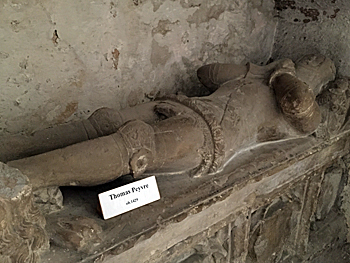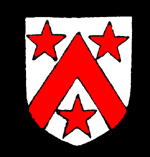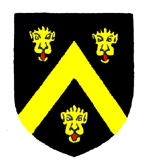The Manor of Toddington
In 1086 Toddington was held by Ernulf de Hesding as a tenant-in-chief of William the Conqueror. Soon after this the manor was granted to William Spec following an exchange of lands. The right of presentation to the church of Toddington appears to have been retained by the Hesding family until one of his daughters, Matilda, granted the church to the Abbey of La Couture in the early 12th century. The descent of the manor during the 12th and early 13th centuries is unclear but by the 1230s it had come into the hands of the Peyvre (or Pever) family. The first member of the Peyvre family to appear at Toddington was Roger Peyvre, who leased land in Chalton from the rector of Toddington in 1198. His son Paulinus prosecuted a lawsuit against the About of la Couture in respect of this land in 1228. In 1230 Paulinus accompanied William de Cantilupe, the King's Steward and lord of nearby Eaton Bray, on an expedition to Poitou (France) as part of his household. In 1217 the manor of Toddington had been held by William Marshal, Earl of Pembroke, and it is likely that he enfeoffed either Roger or Paulinus Peyvre there.
Paulinus Peyvre is known to have built a large and palatial mansion, but there is disagreement over the exact location of the house. It may have been to the north-east of the town at the site of Wadlowes Manor in the area known as Old Park, possibly close to Redhills Farm. While the original Norman manorial hall may have been on the castle site at Conger Hill it is less likely as a site for this new manor house. Other possible sites are the gatehouse of the later manor and the site of Manor Lodge on Park Road. Seven mounds and a small lake are shown here on the Agas map of 1581 which could represent the remains of buildings demolished when the existing manor house was built in the mid-16th century. Peyvre's mansion appears to have been under construction around 1238 when Paulinus received a gift from King Henry III (1216-1272) of two oaks for his house at "Tudingdon". Paulinus Peyvre had followed William de Cantilupe into the royal household and by 1244 had become Steward. He was given more royal gifts of bream in roe to stock his fishponds and oaks to build his chapel of Saint John the Baptist at Toddington. When he died in 1251 his heart was taken to Toddington for burial. The 13th century chronicler Matthew Paris described him as " a lettered knight or knightly clerk … an insatiable buyer of land, a matchless builder of manors … He furnished Tudintuna with a palace, chapel, chambers, and other buildings of stone roofed with lead, orchards, and fish ponds; so as to rouse wonder in those who saw them". His weekly wage bill for building his court at Toddington was £5 or more.

The tomb effigy of Thomas Peyvre June 2015
After Paulinus Peyvre's death the manor was inherited by his son John, a minor. John Peyvre joined Simon de Montfort's rebellion against King Henry III which led to to the confiscation of his lands in 1265, but these were subsequently restored once he proved his loyalty to the King. The manor of Toddington remained with the Peyvre family until the death of Thomas Peyvre in 1429 when it was inherited by his daughter Mary's son John Broughton.

The Broughton family arms
The Broughton family held the manor for a hundred years until 1530, until the death of a later John left his sisters Catherine and Anne to divide the Peyvre and Broughton estates. Toddington was in the share which passed to Anne who married Sir Thomas Cheney. Their son Henry died without an heir leaving Toddington to his widow Lady Jane Cheney. Her nephew Henry Lord Wentworth lived with her at Toddington during the early years of the 17th century, during which time they were visited by King James I (1603-1625). Lady Jane left the manor to Lord Wentworth's son Thomas who later became the Earl of Cleveland. His extravagance left the estate heavily encumbered by debt. The earl and his son fought on the Royalist side in the Civil War; the earl was held prisoner in the Tower of London from 1642 to 1648 and by 1650 both father and son were in exile with the future King Charles II (1660-1685). In 1650 all the earl's lands were sequestered and his debts were found to amount to £100,000. Toddington Manor would have been sold but for the objections of Tristram Woodward and Lady Frances Weld who had heavy mortgage claims on the property.

The Wentworth arms
The Earl of Cleveland returned to England after the Restoration and was buried at Toddington following his death in 1667. His son had predeceased him and his lands were inherited by his granddaughter Henrietta Maria, Baroness Wentworth. Henrietta Maria became the mistress of the Duke of Monmouth, the illegitimate son of King Charles II, who visited her frequently at Toddington. The names of a room in the old house and Monmouth's Oak in the park served as memorials of his visits. After the discovery of the Rye House Plot Monmouth fled to Toddington and it is thought that Baroness Wentworth raised considerable funds to support his rebellion against his half-brother, King James II (1685-1688). She died unmarried in 1686 and Toddington passed to her great aunt Anne, Lady Lovelace, the only surviving sister of the Earl of Cleveland. In 1697 Toddington was inherited by her granddaughter Martha, who became Baroness Wentworth in her own right. She married a rich shipbuilder, Sir Henry Johnson, and in the absence of any children of her own Toddington passed to her step-daughter Anne. By Anne's marriage to Thomas Wentworth, 1st Earl of Strafford the manor passed back to that family. In 1791 the death of their son William left three sisters as heiresses. Toddington Manor was part of the share inherited by Lady Anne Conolly, whose son sold the manor to John Cooper in 1806. The Cooper family remained lords of the manor of Toddington for the rest of the 19th century.
References
Records of Toddington Manor held by Bedfordshire and Luton Archives Service:
- X21/395: Court rolls 1423; 1482-85; 1510-1516 (non-consecutive); 1543, 1570; 1671-1695 (non-consecutive)
- AD1057: Particular c.1650-1680
- P8/28/1: Court roll 1697-1699
- P8/28/2: Court roll1714-1725
- P8/28/3-4: Court rolls 1732-1749
- P8/28/5-6: Court rolls 1755-1758
- BH453: Minute book 1852-1881
- BH456: Steward's correspondence 1873-1908 (non-consecutive); Toddington manor tolls 1876; precept to bailiff 1882; appointment of officers 1882
- Z1506/1: Court book 1875-1896 (non-consecutive)
- BH454-455: Draft court rolls 1882-1884
The location of other early records relating to Toddington Manor can be found through the Manorial Documents Register available on The National Archives website.